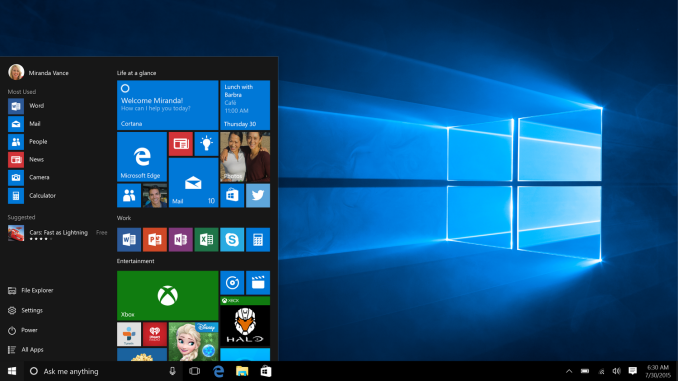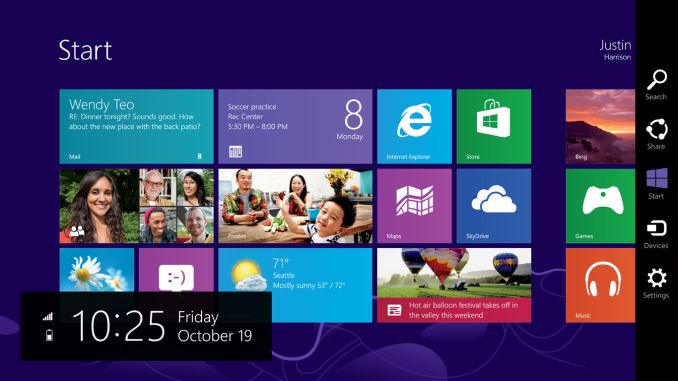The Windows 10 Review: The Old & New Face of Windows
by Brett Howse on August 25, 2015 8:00 AM EST- Posted in
- Operating Systems
- Microsoft
- Windows 10

Let’s flash back to 2012. About three years ago, Windows 8, the last major release of Microsoft’s ubiquitous operating system, was released to manufacturers. This was to be Microsoft’s most ambitious release yet. Traditional PC sales were in decline, and more personal devices such as the iPad tablet were poised to end the dominant PC platform. Microsoft’s response to this was to change Windows more than in any previous release, in a bid to make it usable with the tablet form factor. Windows 8 launched in October 2012 to much fanfare.
There was much fanfare, but little in the way of sales. Yes, Microsoft did sell many copies of Windows 8, but it did not help the declining PC market rebound. Windows 8 came to be with a touch first interface, with a new Start Screen replacing the traditional Start Menu, and a new breed of Windows 8 apps, which run on the WinRT framework. These WinRT apps have been named many things over the past three years, starting with Metro apps. A trademark dispute ended that naming scheme though, and over time they have morphed from full screen apps to universal apps to Windows Store apps, and practically none of them were able to rival the older Win32 platform in popularity or productivity.
Windows 8 did bring some great features to Windows, but they were overshadowed by the major design shift which, while good as a touch based operating system, alienated many who still used Windows on a traditional desktop or notebook. The Start Screen was a big turn off to many people, and full screen apps were not very efficient on a large screen display. Even the multitasking in Windows 8 was less than ideal, with the initial release only allowing two Windows Store apps to be open at any one time, and the second was relegated to a small side bar.
Microsoft’s own faith in Windows 8 was clearly not strong. Only a couple of weeks after Windows 8 launched, they unceremoniously dumped the project head Steven Sinofsky from the company, and spent the next two years trying to make Windows 8 more usable on traditional mouse and keyboard type machines, which were the vast majority of Windows devices in the hands of users. Windows 8.1 arrived and fixed some of the key issues with Windows 8, and 8.1 Update launched with the ability to boot to the desktop, and avoid the touch interface almost completely if you wanted to.
 Windows 10 Start Menu and Desktop view
Windows 10 Start Menu and Desktop view
When looking at Windows 10, I think it is pretty important to look back over the last three years, because none of this is ever built or designed in a vacuum. Microsoft has a huge number of devices running Windows, but a large majority of them are running Windows 7, which was an evolutionary desktop upgrade. Windows 8 struggled to ever take over any of that usage share. Windows 10 is Microsoft’s attempt to bridge the divide. Windows 7 is used by hundreds of millions of people, but its touch support is practically zero. Windows 8 works well in a touch scenario, but is not ideal for keyboard and mouse based devices. Windows 10 promises to be the version of Windows which bridges this gap.
Windows 10 brings about as much change as Windows 8 did, but in almost all cases it is going to be appreciated by users rather than avoided. It will run on a dizzying number of device types, including the traditional desktop, notebook, tablet, two-in-one, phone, IoT, Raspberry Pi, Hololens, Surface Hub, and even Xbox One. What it will bring to each of those device types is not the single interface that Windows 8 pushed on the desktop, but a unified app platform. Each device type will have its own interface, but the underlying app platform will allow developers to target a huge number of devices. And developer buy-in is the one thing Microsoft needs more than any other in order to make this vision succeed. For all of Windows 8’s quirks, it was really the lack of quality apps in the Windows Store which was the one hurdle Microsoft could not code around. Only time will tell whether or not the new model succeeds where the old one failed, but at the beginning of the life of Windows 10 we can go through all aspects of it and see what’s new, what’s changed, and how it fits in on today’s devices.











293 Comments
View All Comments
tonytroubleshooter - Wednesday, August 26, 2015 - link
they dont care about licensing it, they care about people installing a "OMG free Win 10 upgrade", with Cortanana and privacy settings enabled. Soon as the number of WIn10 installs with express settings goes up, so will the money stacks from advertisers to MS. for shame MS, for shame... shadowing Google like a biznitch....BobSwi - Tuesday, August 25, 2015 - link
Sticking with 7, and likely next upgrade will be linux with windows in a VM. Virtual box has let me ttest drive so many OS's, Mint, Debian, Slackware.n0b0dykn0ws - Tuesday, August 25, 2015 - link
I know I'll be in the minority, but this OS suffers from the same flaw that Windows 8(.1) did. It offers little reason to upgrade and takes away things that I use.I still use Windows Media Center because it is the most polished modern DVR platform for Windows. Either products were dumped years ago and are only available as their last release, or there are modern platforms that you have to spend vast amounts of time configuring and when it finally does work you have to pray that the next release doesn't break it.
There is a sliver of hope with SiliconDust's forthcoming DVR software, but until it is in final release and I can finally know the final technical details of the platform I am forced to continue using Windows 8.1 on all three of my desktops.
There just isn't enough 'new' in Windows 10 to make it worthwhile jumping ship. Especially given that features such as Cortana I am no longer interested in using.
vLsL2VnDmWjoTByaVLxb - Tuesday, August 25, 2015 - link
One troubling aspect of this ecosystem is I've had trouble using my Microsoft account, including Onedrive, too many times. What is happening right now and for the past few weeks on my work system is a continual prompt to provide credentials when I save documents. It makes getting work done nearly impossible, and I'm considering abandoning this setup I've had for quite some time.Previously I've had issues with syncing and adding extra space to my Onedrive account. All in all it's the heart of much of this ecosystem and I've lost trust in it, and therefore, much of my trust of Windows in general. It's my data, why must you make me struggle to access it?
basroil - Tuesday, August 25, 2015 - link
"Accessing all apps is different than Windows 7 because there are no folders on the Start Menu. Instead there is just an alphabetical list of all apps that you can scroll through."There ARE folders in Windows 10 start menu/screen, I have ~10 of them ranging from Blender to Visual Studio 2015!
Brett Howse - Tuesday, August 25, 2015 - link
I updated the text. Sorry about that I actually was meaning hierarchical folders like Programs->Accessories->System Tools but I see that what I said was not correct. Thanks for pointing it out!AlexIsAlex - Tuesday, August 25, 2015 - link
It's a shame, I really wanted to like Windows 10, and had it pegged as an upgrade from 7. It's certainly an improvement over 8, but I'm just not seeing anything convincing over 7 for a desktop. For the desktop use case (no touch, no wifi, no apps - full applications only please) where I will not accept an MS Account login (no Hello, no Store, no Cortana, no OneDrive), that leaves precious little. Slightly faster file copies and a nicer task manager, it seems.Then there's the new visual look/design language, which I can't say I really like, personally (this is supposed to be client side software, not a website), and the inconsistent UI between Metro and Desktop - seriously, just try right clicking in the start menu (Metro) compared to the task bar (Desktop).
There's Edge I suppose. Better than IE, granted. Not as good as Firefox.
Oh well. I guess we'll all have to migrate eventually. But until forced, I'm sticking with 7.
Victor84 - Tuesday, August 25, 2015 - link
Sums it up pretty well, could not agree more.trparky - Tuesday, August 25, 2015 - link
Firefox? You bring that piece of crap up? That thing will gladly eat through your RAM like a pig. I can't stand Firefox anymore and that goes for anything built on Firefox. The engine itself is garbage. Or, and did you hear that Mozilla will be abandoning XUL and thus all existing extensions will be obsolete?You don't need to tie your Microsoft Live Account to your Windows login if you don't want to. All you need is a Microsoft Live Account and Windows 10 will allow you to individually sign into the Store, OneDrive, etc.
You probably have a Google Account. Same thing, different company.
Oxford Guy - Tuesday, August 25, 2015 - link
Chrome has been linked to issues with memory leakage. I think Chrome is highly overrated.